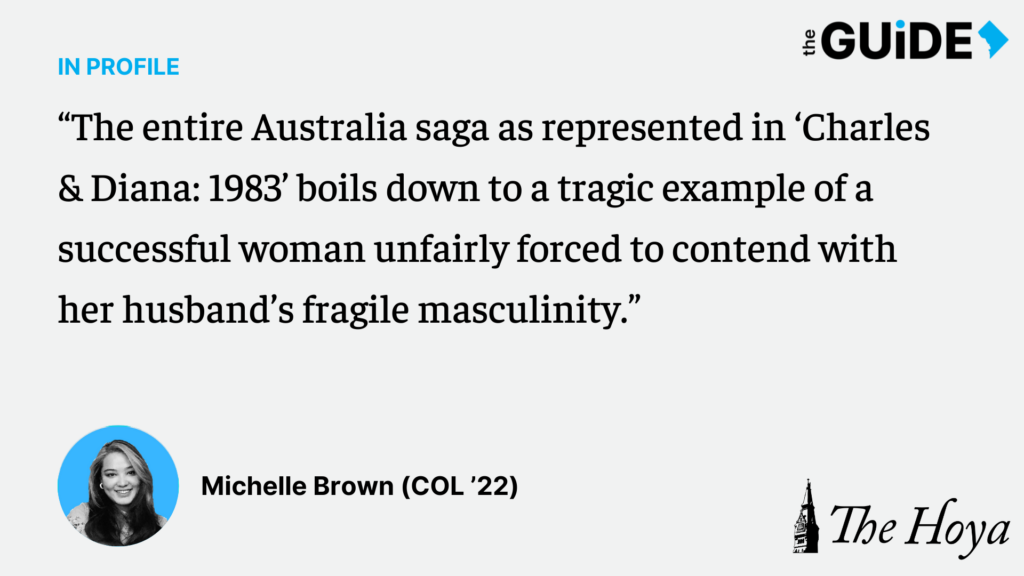I am embarrassingly invested in the activities of the British royal family. As nonsensical as it might be, I, an American who has maybe left the country twice and never been anywhere near the United Kingdom, am obsessed with the goings-on across the pond.
I can take comfort, however, in knowing that I am not alone in my fascination with the royals — Princess Diana especially — since “The Crown” and comparisons of Meghan Markle to Diana have piqued public interest in the family. I was aware of Princess Diana’s would-be 60th birthday last month and took the opportunity to watch a Diana documentary that offers a heart-wrenching look at her torturous marriage.
The film, “Charles & Diana: 1983,” released earlier this year, is based around the chaotic royal couple’s tour of Australia two years after their showstopping nuptials. The famed royal assignment in 1983 displayed to the world just how intense Diana-mania really was, as crowds in every city that the pair visited clamored to see the princess.
As director Jordan Hill highlights, Diana would be walking along one side of the street greeting starstruck fans and regaling them with talk of her baby Prince William, and, as soon as she turned to pay the other side of the street equal attention, the crowd would suddenly cheer with equal parts elation and relief. Prince Charles even joked one evening to a dinner crowd, “I’ve come to the conclusion, it would have been far easier to have had two wives to have covered both sides of the street, and I could have walked down the middle directing the operation.”
A crucial part of this story and the Australia tour, though, is that while Diana’s easy charm proved a great asset to the royal family — with media outlets proudly proclaiming she’d won the heart of Australia — Prince Charles felt deeply threatened by her popularity.
To me, the entire Australia saga as represented in “Charles & Diana: 1983” boils down to a tragic example of a successful woman unfairly forced to contend with her husband’s fragile masculinity. Rather than forging a genuine partnership with and uplifting Diana, who advantageously breathed playfulness and youth into an antiquated institution, Charles ensured that their relationship was a rivalry.
Of course, competitiveness in general in a relationship, specifically in Charles and Diana’s relationship, is not always the product of gender norms — which traditionally position the man as the provider, the family figurehead, the alpha — coming into conflict with reality. Prince Charles is also a future king; it makes sense that he would expect a certain level of fanfare for himself.
The documentary points to video and snapshots of the pair’s trip to Ayers Rock in the Northern Territory in Australia, where Diana appears to shyly trail Charles, evidence of trouble in paradise. Commentators in the documentary claim Diana looked profoundly sad beside the Prince of Wales. Over a decade later, Diana confirmed that Charles jealously dwelled for weeks on her triumphant reception in Australia.
On the whole, the press clips and commentaries in “Charles & Diana: 1983” repeat many of the same criticisms of the Wales’ relationship that followers of the family have been well aware of for years: Charles’ affair with Camilla Parker Bowles, Diana’s isolation and enduring outsider status within the family, and their decade age difference and resulting total lack of common interests. But by using Australia as a case study — by picking this key, and very publicized, moment in their marriage — viewers see Charles’ jealousy come to the fore.
The dynamic between the two during the Australia tour, and more importantly Charles’ competitiveness and feelings of inferiority, is not novel. When it comes to couples in the public eye, Charles and Diana exemplify a phenomena of men feeling threatened by rather than proud of their female partners’ success. For instance, the royal dynamic is comparable to the tension between Scarlett Johansson and Ryan Reynolds, with their relationship taking the form of a marriage and a competition at the same time.
Still, it does appear to be the case that misogyny can play a role in one’s inability to celebrate the achievements of their partner. As “Charles & Diana: 1983” illustrates, in Charles’ view, it simply wasn’t a good look to be outdone by his wife. And while spectators of the royal couple in March 1983 might have seen the Australia tour as Diana’s great triumph, she likely felt it to be an early indicator of the turbulence that lay ahead in their marriage.














